

We say f has an absolute maximum on I at c if f(c)\ge f(x) for all x\in I. Associate with each patient aLet f be a function defined over an interval I and let c\in I. 2) A hospital with a set of patients and a set of medical doctors.
An absolute extremum may be positive, negative, or zero. First, the term absolute here does not refer to absolute value. Construct a pie chart to represent the data.Before proceeding, let’s note two important issues regarding this definition. Organize the given data by creating a frequency distribution. The following results were obtained: a. If f has an absolute maximum on I at c or an absolute minimum on I at c, we say f has an absolute extremum on I at c.To study the library habits of students at a local college, thirty randomly selected students were surveyed to determine the number of times they had been to the library during the last week.
A container type that holds relevant metadata for module loading. SinceA compiled JavaScript script, tied to a Context which was active when the script was compiled. For example, consider the function f(x)=1/(x^2+1) over the interval (−\infty ,\infty ). The real number c is a point in the domain at which the absolute extremum occurs.

If the interval I is open or the function has even one point of discontinuity, the function may not have an absolute maximum or absolute minimum over I. For the extreme value theorem to apply, the function must be continuous over a closed, bounded interval. There are a couple of key points to note about the statement of this theorem. Typically, it is proved in a course on real analysis. 12 14 7 40 5 22 19 15 34 11 20 14 28 17 2 30 30 29 9 22 36 24.The proof of the extreme value theorem is beyond the scope of this text.
The function has an absolute maximum over but does not have an absolute minimum. Although the function in graph (d) is defined over the closed interval , the function is discontinuous at x=2. The extreme value theorem cannot be applied to the functions in graphs (d) and (f) because neither of these functions is continuous over a closed, bounded interval. However, the function in graph (e) is the only one that has both an absolute maximum and an absolute minimum over its domain. All three of these functions are defined over bounded intervals.

The local extrema occur at x=0, x=1, and x=2. In these cases, how can we use a formula for a function to determine where these extrema occur?To answer this question, let’s look at (Figure) again. Also, we may not have a graph of the function. However, it is not always easy to see, since the interesting features on the graph of a function may not be visible because they occur at a very small scale.


 0 kommentar(er)
0 kommentar(er)
